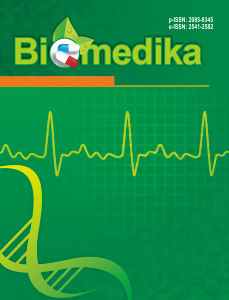Overview Of Gluten-Free Casein-Free Diet Application in Children With Autism Spectrum Disorder
DOI:
https://doi.org/10.23917/biomedika.v16i1.3854Keywords:
Autistic Spectrum Disorder, Gluten-Free Casein-Free, Diet ImplementationAbstract
Background: The theory that gluteomorphin and casomorphin can act as opiate-like peptides has an effect like opiates by binding to specific receptors in the central nervous system, which triggers the implementation of a casein-free gluten-free diet (GFCF). The binding of gluten and casein derivates in these specific receptors leads to increased activity of the endogenous opioid system associated with symptoms of autism spectrum disorder. Objectives: To describe the application of a casein-free gluten-free diet in children with autism spectrum disorder (ASD). Materials and Methods: We conducted this research with cross-sectional design quantitative research using total sampling (38 respondents, all female, mother) in July-August 2021 with a food frequency questionnaire (FFQ). Results: The result revealed that the average age of ASD children is 10.47 years, weight 35.87 kilograms, height 141.45 centimeters, and mostly boys (68%). Most parents (86.8%) didn’t adopt a GFCF diet. FFQ score mostly amounting to >150 (57.9%). Conclusion: ASD children in SLB Autis Kalbar are given foods with gluten and casein with diverse variations enough that children have an FFQ score >150, and their parents didn’t implement GFCF diet.
Downloads
Downloads
Submitted
Accepted
Published
Issue
Section
License
Copyright (c) 2024 Biomedika

This work is licensed under a Creative Commons Attribution 4.0 International License.












